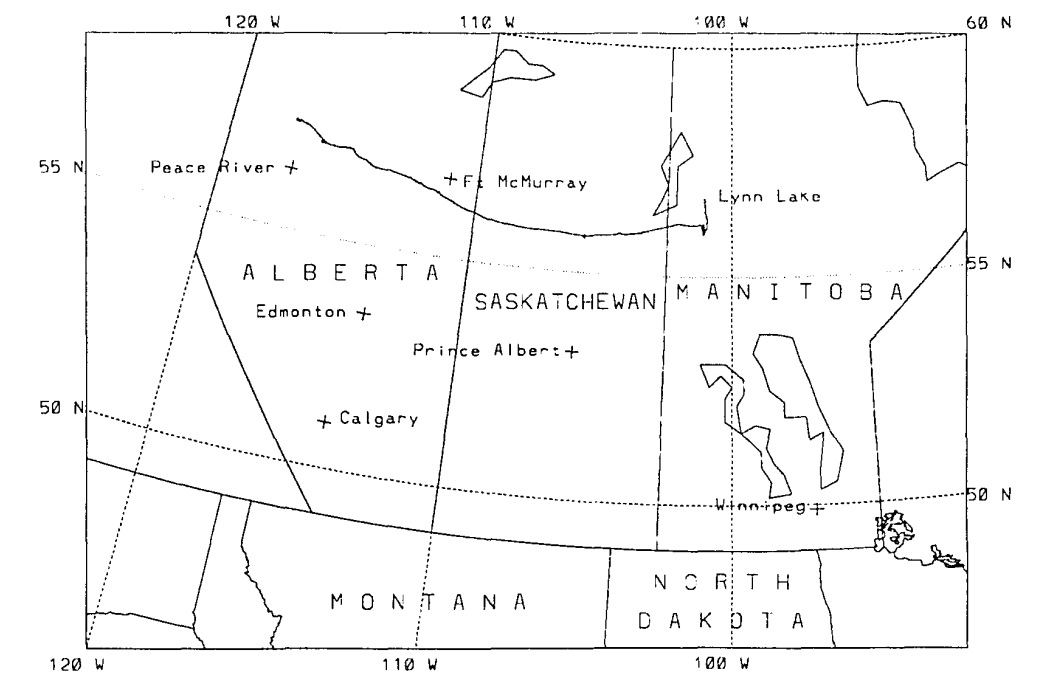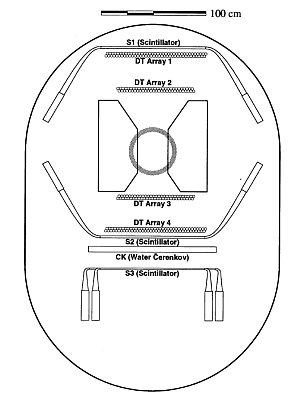Purpose of the flight and payload description
SMILI (sketched in the figure at left) was an instrument that was designed to measure the isotopic abundances of cosmic rays over a large range of elements, from hydrogen to boron, and over a large range of energies, from below 100 to greater than 2000 MeV. It was a direct descendent of another instrument called PBAR, flown in 1987 which was optimized for low background antiproton studies.
It consisted of two layers of plastic scintillators, 16 layers of drift tubes, and a superconducting magnet. The charge and velocity were determined for each cosmic-ray particle from the scintillator signals. Momentum was determined for each particle by measuring its deflection in the magnetic field with the drift tubes. Mass was determined by combining the momentum and velocity measurements.
At the heart of SMILI was a split-coil, room-temperature bore, superconducting magnet with a field of 1.5 Tesla and an acceptance of 205 square cm. As charged particles entered and exited the magnet bore, their positions and directions were measured by an array of 510 thin-walled drift tubes arranged in four modules, two with the tube axes parallel to the magnetic field (the bending view) and two with axes perpendicular to the field (nonbending view). Each module consisted of two sections of two close-packed planes, providing a total of 16 planes. A 20 micron diameter gold-plated tungsten wire was strung down the center of the tube while a gas mixture of 50% argon and 50% ethane flowed serially through them, slightly above the ambient gondola pressure of 1 atm. Each tube is read out from one end by an amplifier/discriminator, and the discriminated signals are fed to time-to-digital converters (TDCs).
The time-of-flight (TOF) system consisted of two planes of plastic scintillator located 1.8 m apart, and formed each plane of several scintillator slabs 100 cm long by 25 cm wide by 1.9 cm thick. S1 was located above the upper drift tubes and included four such paddles, while S2 was located below the lower drift tubes and included three. The scintillation light was channeled through bent light pipes into photomultiplier tubes (PMTs), one at each end of each paddle. After passing several electronic filters and discriminators the signals are fed to TDCs where the time and pulse height were used to determine particle velocity and charge.
A water cerenkov counter is located below S2 to provide a redundant measurement of the particle velocity and to improve the resolution of the TOF system. It uses higly purified water as radiator medium, stored in a light integration container 5 cm thick and approximately 100 cm by 90 m in size. It is viewed by 20 PMTs arranged in pairs.
Finally at the bottom of the instrument placed directly below the CK detector was an interaction detector (S3) consisting of four slabs of plastic scintillator viewed at each end by several PMTs through light pipes. This provided an additional measurement of the particle charge and was used to reject events which interacted in the CK detector.
All the information of the events detected is readout using a LSI-ll/73 microcomputer, and telemetered to the ground station using a pulse code modulated signal. In addition to event data, periodically the flight program would telemeter also housekeeping information (temperature, pressure, supply voltages, etc.) andcalibration data from SMILI subsystems. The demodulated data stream was recorded on analog tapes by the National Scientific Balloon Facility, while a digital data stream was monitored in real time by the SMILI ground station which also has the ability to send simple commands to the instrument which were used to control the high voltage levels and other instrument parameters.
The entire instrument was surrounded by a egg-shaped aluminum shell covered with polyurethane foam, painted white, which serves as a passive thermal control system insulating the detectors while reflecting incident sunlight.
Details of the balloon flight

Balloon launched on: 7/25/1991 at 2:17 utc
Launch site: Lynn Lake Airport, Manitoba, Canada
Balloon launched by: National Scientific Balloon Facility (NSBF)
Balloon manufacturer/size/composition: Zero Pressure Balloon Winzen 29.470.000 cuft (SF3-424.37-080-NSCHR-04)
Balloon serial number: W29.47-3-15
Flight identification number: 313N
End of flight (L for landing time, W for last contact, otherwise termination time): 7/26/1991 at 02:27 utc
Balloon flight duration (F: time at float only, otherwise total flight time in d:days / h:hours or m:minutes - ): 22 h
Landing site: 75 miles N of Peace River, Alberta, Canada
The balloon was launched from Lynn Lake airport in Manitoba using a crane as launch vehicle at 2:17 utc on July 25, 1991. After a nominal ascent phase that endured 3 hours and 40 minutes, the balloon reached float altitude of 35 km about 6:00 utc.
The ground station in Lynn Lake recorded data during the first 12 hours of the flight, while during the next 12 hours data were recorded by the ground station in Ft. McMurray.
The flight was terminated at 0:29 utc on July 26, 1991 at latitude 57° 21' North and longitude 117° 30' West and the instrument was recovered 70 miles north of Peace River in Alberta.
This was the second and last mission of the instrument.
During the flight, about 5 million events satisfied the hardware trigger. Most of these corresponded to particles that passed through material in the magnet's cryostat, and many of these were of poor quality due to nuclear interactions or scattering.
These were the first measurements of the abundances of lithium, beryllium, and boron with good mass resolution beyond 1000 MeV.
External references
- A Study of the Abundances of Light Isotopes in Cosmic Rays With a Superconducting Magnet Instrument PH.D. Thesis by Michal Lijowski, Louisiana State University (1994)
- Current Progress of the SMILI Light Isotope Spectrometer Program 21st International Cosmic Ray Conference. Volume 3, p.35
- High resolution drift tube hodoscopes for cosmic ray studies Nuclear Instruments and Methods in Physics Research 323(1-2)
- Measurement of the Isotopic Composition of Cosmic-Ray Helium, Lithium, Beryllium, and Boron up to 1700 MeV per Atomic Mass Unit The Astrophysical Journal, 534:757-769, 2000 May 10
- Measurement of the Isotopic Composition of Cosmic-Ray Helium, Lithium, Beryllium, and Boron up to 1700 MEV per Atomic Mass Unit The Astrophysical Journal, Volume 534, Issue 2, pp. 757-769
- NASA Balloon Flights (1989-1998) in NASA Historical Data Book, Vol. VII: NASA Launch Systems, Space Transportation, Human Spaceflight, and Space Science, 1989-1998
- Smili: a Superconducting Magnet Instrument for Light Isotopes 20th International Cosmic Ray Conference Moscow, Volume 2, p.374
2603If you consider this website interesting or useful, you can help me to keep it up and running with a small donation to cover the operational costs. Just the equivalent of the price of a cup of coffee helps a lot.


